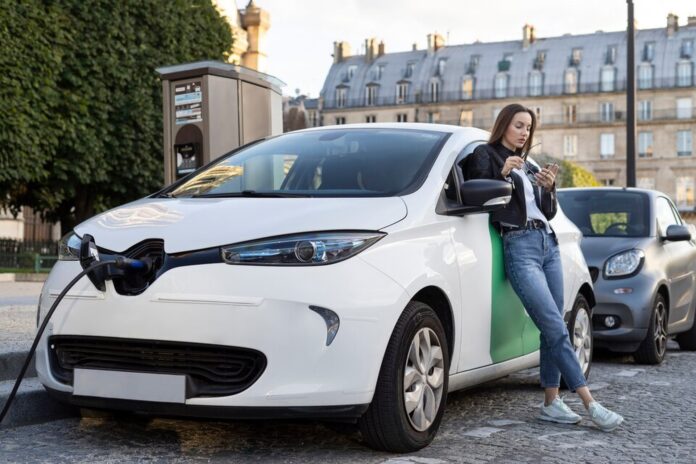Understanding the Basics of Electric and Diesel Fleet Options
Transportation fleet management is changing. Businesses are considering possibilities. They include diesel and electric fleets. Each kind has benefits and qualities. Electric fleets are battery-powered. They operate emission-free. Diesel fleets use combustion engines. Due to their success, they remain popular. Making educated judgments requires understanding these foundations.
EVs are growing in popularity. Their running expenses are cheaper. Tax advantages are offered. Environmental advantages motivate many firms. Challenges exist. Charging infrastructure is evolving. Some drivers have range anxiety. It challenges trustworthiness. Diesel cars have a long history. They’re powerful and torquey. Their infrastructure is solid. Fuel availability is fine. However, they emit greenhouse gasses. Many cities restrict diesel use.
Fleet managers must choose between electric and diesel. Each choice meets distinct demands. Consider operational objectives before deciding. Check your daily travels, car range, and filling stations. Safety first. Understanding electric and diesel fleet basics helps make the appropriate choice. It educates fleet managers on sustainability. Electric transportation is forthcoming. Businesses must adapt to these changes to compete.
Cost Analysis: Upfront Investment Vs Long-term Savings
The cost might be crucial. The higher initial investment is typical for electric fleets. Compared to diesel, electric cars are expensive. Long-term savings often affect the equation. Electric cars (EVs) operate cheaper. They cost less to maintain and fuel. Charging is cheaper than diesel. This saves many people a lot throughout the life of the car.
The initial investment is difficult for charging infrastructure. Installing chargers costs money. These expenditures may impact fleet management budgets. Government incentives may reduce these costs. Tax incentives may ease electric fleet transitions. To obtain a realistic picture, consider the entire ownership cost. Think beyond upfront expenses. Assess fuel, maintenance, and resale value. Maintenance is more expensive for diesel cars. Basic services like oil changes are crucial. Additionally, diesel prices vary. This may affect operations budgets.
Electric fleets may save money over time. Battery technology will improve, say predictions. Costs will fall, increasing company savings. Fleets may prepare for the future by investing in electrification. Electricity becomes more feasible as technology advances. Analyzing these financial factors helps balance decisions. Current investments must be weighed against future savings realistically.
Performance Comparison: Speed, Power, And Efficiency
Fleet managers value performance. Diesels are well-regarded. Their strength and speed are impressive. Drivers like its performance in tough conditions. EVs can compete, particularly in torque. They give power instantly. They have an advantage in urban driving. The effectiveness of each system varies. Diesel engines usually handle big loads effectively.
Energy-efficient electric motors excel. Electric vehicles need more stored energy to move. This efficiency cuts energy waste. Fleet managers must evaluate real-world performance. Diesel engines are long-haul champions. Durability is their design. Many industries depend on diesel for road dependability. Electric cars are improving. Longer lengths are becoming possible. Advances in battery technology reduce range anxiety.
Payload capacity and weight distribution are important. Diesel is essential for heavy hauling. Electric cars are improving but remain limited. Fleet managers should assess needs. Consider fleet selection and operational responsibilities and routes. Performance goes beyond speed. Reliability, flexibility, and different operating issues are included.
Maintenance Considerations: Electric Vs Diesel Fleets
Maintenance is crucial to fleet management. Maintenance needs for electric and diesel fleets varied greatly. Diesel cars need frequent upkeep. Oil changes, filter replacements, and exhaust system inspections. These steps take time and money. Fewer components move in EVs. Less maintenance is needed. No oil changes are needed. Regenerative braking reduces wear.
Electric fleets often minimize downtime. Lower service frequency increases availability. Maintenance factors should be considered by fleet management. Monitoring electric systems throughout time is crucial. Performance depends on battery health. Regular checkups keep the car running smoothly. Assess the expenses of sustaining both fleets. Diesel fleets may cost more to maintain. Electric fleets may need more charging infrastructure upfront.
Training is another factor. Staff may require electric system training. Effective EV maintenance requires knowledge. Diesel mechanics must also keep up with new tech. Overall, maintenance should support operational plans. Vehicle selection must be based on fleet goals.
Driver Experience: Comfort and Usability of Electric vs Diesel
Never neglect driver experience. This is particularly true when deciding between electric and diesel fleets. Driving for extended hours requires comfort. Electric cars please many drivers. Electric cars travel quietly. Noise is much lower than in diesel cars. This makes driving more enjoyable.
Usability matters, too. Modern technology is in many electric automobiles. Enhanced features include regenerative braking. This technique saves energy and improves comfort. This is typically lacking in diesel automobiles. They may use old tech. Upgrades cost and take time.
Driving an electric car is different from diesel. Electric motors‘ rapid torque makes driving exhilarating. Many drivers like EVs‘ responsiveness. However, diesel cars feel strong. This may reassure drivers in difficult situations.
Cabin aesthetics and design affect experience. The interiors of electric cars are usually large and well-designed. Fleet management should respect drivers‘ wishes. They affect work happiness and productivity. Fleet choices should prioritize user experience. Well-informed choices boost productivity and employee satisfaction.
What Are The Main Differences Between Electric And Diesel Fleets?
The biggest differences are power and maintenance. Diesel fleets employ combustion engines, whereas electric fleets use batteries. Electric cars are cheaper to operate. Diesel operates better under load. Electric cars cut pollution and are quieter.
Do Electric Vehicles Have A Higher Upfront Cost Than Diesel Vehicles?
Electric cars are more expensive initially. However, long-term savings may compensate. Consider fuel, maintenance, and tax breaks. Analyzing costs helps choose the best choice.
What Are The Environmental Impacts Of Electric Versus Diesel Fleets?
Electric fleets are greener. They operate emission-free. Greenhouse emissions come from diesel cars. Emission laws are expanding to reflect their environmental effect. Electricity can help sustainability.
How Does Driver Comfort Compare Between Electric And Diesel Vehicles?
Vehicle models affect driver comfort. Electric cars ride quietly. Classic diesel power and dependability are available. Comfort depends on your taste. Truck design and technology also affect driving enjoyment.



















